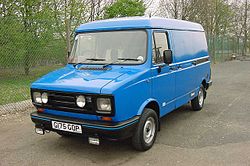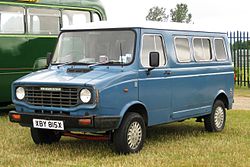- LDV Pilot
-
LDV Pilot 
1999 2.2T PilotManufacturer LDV Limited Production 1997–2006 Predecessor Leyland DAF 200 Series Successor LDV Maxus Class Van Related LDV Convoy Leyland DAF 200 Series 
Manufacturer Leyland DAF Also called DAF 200 Series Production 1989 – 1997 Predecessor Freight Rover 200 Series Successor LDV Pilot Class Van Related Leyland DAF 400 Series Freight Rover 200 Series Manufacturer Freight Rover Production 1984 – 1989 Predecessor Freight Rover Sherpa Successor Leyland DAF 200 Series Class Van Related Freight Rover 300 Series Freight Rover Sherpa 
Manufacturer Freight Rover Production 1982 – 1984 Predecessor Leyland Sherpa Successor Freight Rover 200 Series Class Van Leyland Sherpa
(later Morris Sherpa)Manufacturer British Leyland/BL (Austin Morris division) Production 1974 – 1982 Predecessor Morris J4 Successor Freight Rover Sherpa Class Van The LDV Pilot is a panel van that was produced by LDV Limited from 1997 until 2006, and closely based on preceding models dating back to 1974 (which were in turn related to older models).
The Pilot was available in capacities from 2.2 to 2.6 tonnes in a 5.7 cubic metres (200 cu ft) load area. Power came from a 1.9 litre Peugeot Diesel engine driving the rear wheels through a 5 speed gearbox. Access to the load area is from either the rear or a sliding side door.
Contents
History
Hewn from the Morris/BMC J4 vans of the 60s, the core vehicle went through a series of developments, the main one being the revision of the forward control layout of the J4 and moving the engine ahead of the cab and accessible via a bonnet. This allowed the wheelbase to be extended resulting in greater stability, payload, side loading and the distinctive 'Sherpa' profile (though the last of the J4s and the first Sherpa are largely identical from the rear). The Sherpa gave way to the Freight Rover 200 Series and in turn the Leyland DAF 200 Series before finally becoming the Pilot after LDV was formed in 1993. It was originally designed to be built on car production lines which led to it having a narrow track. This feature was made into a virtue in later publicity by stressing its ability in narrow city streets.
Sherpa 1974-82
Originally developed by British Leyland the model was launched in 1974 under the nameplate Leyland Van. A year later the name of the model was changed to the Leyland Sherpa. The Sherpa would then be branded by Morris and later Freight Rover.
The initial Sherpa line-up consisted of vans in 185, 215 and 240 versions (where 185 denotes a GVW of 1.85 tons, and so on); pick-ups in 215 and 240 versions; a 240 crewbus and minibus; and various chassis-cab options in 220 and 250 versions. Payloads were quoted as 13/14cwt for the 185; 18/19cwt for the 215 and 220; and 22/23cwt for the 240 and 250. Loadspace, at 190 cubic feet (5.4 m3), was considerably higher than that of the J4 and only just short of the 250JU's.
In 1978 the 1.7- and 2.0-litre O-series engines replaced the original 1622 cc and 1798 cc B-series petrol units, while the 1798 cc B-series diesel stayed put. The range was redesignated accordingly:- vans: 200, 230 and 250; pick-ups: 230 and 250; minibus and crewbus: 250 only; chassis-cab: 255 only. A few months later, the Sherpa was rebadged as a Morris. In 1981, BL created the Freight Rover division as part of the Land Rover group, so the Sherpa's badges were changed again.
Sherpa K2 Series 1982-87
The short-lived K2 Sherpa had a neater appearance and much improved side-access to the load bay. The Sherpa van could now be bought in 200, 230, 250 and 280 versions. The crewbus and minibus continued in 250 form. Loadspace remained at 190 cubic feet (5.4 m3), but a new "Hi Capacity" walk-thru body was also offered, built on either the 255 or 280 chassis-cab, and offering 330 cubic feet (9.3 m3) of loadspace. An optional Luton body took loadspace up to 460 cubic feet (13 m3), again with a choice of basic chassis-cab GVWs.
The original, integral pick-up had now been dropped in favour of a drop-side pick-up built on the Sherpa chassis-cab. The 255 and 280 chassis-cabs were also available on their own, ready to receive bespoke bodywork. Engine availability continued unaltered, with 1.7 and 2.0-litre O-series petrol units, the 1.8-litre B-series diesel and the option of a Landi-Hartog LPG conversion, first introduced at the launch of Freight Rover the year before. A 4WD Sherpa van was also now offered.
Freight Rover 200 Series 1984-89
With the next facelift, the Sherpa (now known as the Freight Rover 200 series) gained square headlamps, new bumpers and repositioned indicators. Alongside the original bodystyle there was new wide-bodied variant (Freight Rover 300 series). The 200 series was initially available with a 2-tonne GVW. The capacity for the 200 series remained at 190 cubic feet (5.4 m3).
A Luton-style body was offered, built on the 255 chassis-cab, providing a capacity of 400 cubic feet (11 m3), and a maximum payload of almost 2 tonnes. The chassis-cab also formed the basis for drop-side pick-ups, in 255, 280 and 285 versions, again avaialble with either short- or long-wheelbases. Of course, the chassis-cab could also be ordered on its own, again in a choice of lengths, so that bespoke bodywork could be fitted, with the added option of either single or double cabs. The 200 series continued to be offered as minibus or crewbus.
While the K2 Sherpa's engines remained available (including the ancient B-series diesel), a 2.5-litre diesel unit was now offered on the 300 series, and following the completion of a special Police contract, the Rover 3.5-litre V8 unit also became available from 1986. The B series diesel bowed out shortly after this in the 200 series, replaced by the 2.0 NA direct injection Diesel Rover MDi / Perkins Prima, (as found in Maestros and in turbocharged form in Montegos and late Maestros (from 1992-94)) which was effectively a dieselised BL O series engine. This was a somewhat raucous, noisy and unrefined engine but was however a very reliable unit capable of excellent fuel economy, although performance of the naturally aspirated engine was not a strong point. As a city van it was adequate but totally unsuitable for motorway work. However, with the sale of Freight Rover the following year, the Rover Group ceased to be a player in this sector of the light commercial market.
Leyland DAF 200 Series 1989-97
With Freight Rover becoming Leyland DAF, the 200 series was given a new radiator grille, bearing the Leyland DAF badge. The 200 series was built on car lines and its narrow width meant it became a very popular city van. The last 200s switched from the Perkins Prima engine to the less economical but more refined, naturally aspirated indirect injection PSA XUD 1.9L engine.
LDV Pilot 1997-2006
Following the sell-off of the van business from the insolvent Leyland DAF in 1993, LDV Limited was formed. The newly independent company renamed the 200 van the Pilot. The van received a facelift of, new modernising and less boxy front panels and a redesigned dashboard and seating. The facelift also saw the end of the '80s Rover stalks, but not the instruments and minor switchgear.
The van would become popular as a minibus and would come in pick-up and fleet based vans. Power arrived in the form of a Peugeot 1905 cc diesel engine throughout the entire range, however it made the Pilot sluggish and only able to achieve 75 mph (121 km/h) (One of the rare versions with the turbocharged version of this engine was an altogether more satisfying drive). It also had little torque meaning most hills required you to change down. Early models have basic interiors consisting of 2 or 3 seats, Mountain Blue coloured plastic dashboard and LDV branded FM/AM cassette radio. Gears are selected using the now unpopular floor mounted gear stick. The van was also used by various Police forces and the Royal Mail. In 2007 a poll of over 100,000 commercial vehicle magazine readers voted the Pilot National Van Of The Year 2007 despite production ending in 2006.[citation needed]
Turkish variant
A Sherpa-derived van[1] was also produced in Turkey by BMC Sanayi ve Ticaret A.S., and as of 2006 a pick-up derivative is also sold. This is not promoted in the United Kingdom market.
Film appearance
A first generation Sherpa van made an appearance in the 1977 James Bond film The Spy Who Loved Me which was driven by the villainous Jaws (Richard Kiel) on a journey through the Sahara Desert, with Bond (Roger Moore) and his partner Anya Amasova (Barbara Bach) hiding in the back in their quest to recover a microfilm crucial to their mission. They managed to escape in the vehicle after retrieving the microfilm but were unable to complete their journey due to the damage that Jaws had inflicted upon it in his earlier attempt to prevent them from escaping. [1] In Billy Elliot movie there was a Leyland Sherpa (1984) which was given 2 stars by IMCDB.
See also
- LDV Limited
- LDV Convoy
- LDV Maxus
Notes
- ^ "BMC Levend". BMC Turkey. Archived from the original on 2006-10-23. http://web.archive.org/web/20061023214240/http://www.bmcsan.com/eng_levend_60_pickup.asp.
References
- The Sherpa family at the unofficial Austin/Rover resource site
- The official performance ldv pilot site and owners club
External links
Categories:- LDV vehicles
- Vans
Wikimedia Foundation. 2010.

